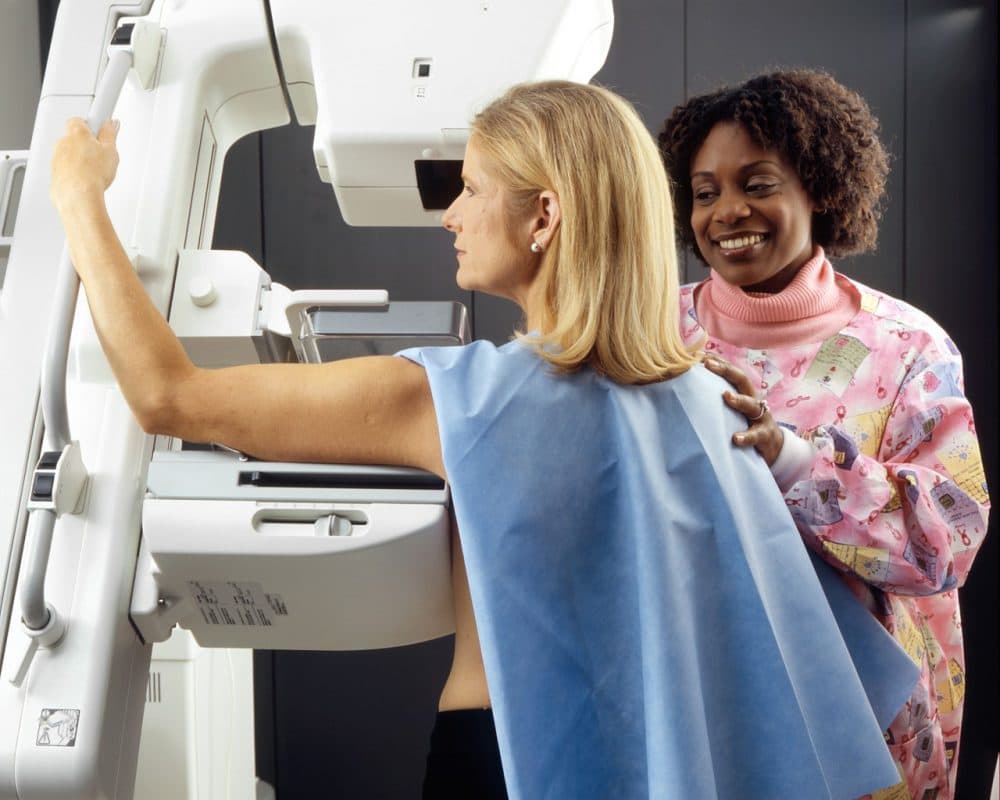Advertisement
New Review Finds Benefits Of Mammograms Overestimated

For women in their 40s, 50s and beyond, there are new recommendations every few years about mammograms. The question is, how useful are they at detecting breast cancer? And does the potential harm of mammograms outweigh the potential benefits?
Now, we can answer those questions with a bit more certainty — thanks to a comprehensive review of 50 years' worth of international studies on mammograms. The bottom line is the benefits of screening are often overestimated, while the potential harm is often underestimated.
The findings have just been published in the latest edition of the Journal of the American Medical Association.
Guests
Carey Goldberg, co-host of WBUR's CommonHealth blog. She tweets at @commonhealth.
Dr. Nancy Keating, associate professor of Health Care Policy at Harvard Medical School and a co-author of the new report.
Highlights
On the ongoing debate over mammograms:
Carey Goldberg: "This is part of a bigger, complicated question about cancer screening in general. The idea is that we want to get checked for cancers because if you catch them earlier you can cure them better. But the problem is that screening can often pick up cancers that really never would have gone anywhere. We’ve seen this sort of controversy in screening for prostate cancer in men, we’ve seen it a little bit on colonoscopies, although they’re still looking very strong and then we’ve also seen it with mammograms, particularly since 2009 when the federal guidelines changed a little bit and suggested that women really start getting them more like at the age of 50 and more like every other year than every year."
On the questions Dr. Keating sought to answer in her review:
Dr. Nancy Keating: "First, what are the benefits of screening mammography? Second, what are mammography's chief harms? Third, following from the U.S. preventative services task force recommendations that we should individualize decisions about mammograms, what information is out there about how to do that? And then fourth, what do we know about how to support women and their physicians in making the right decision for that patient?"
On the answers:
NK: "For the benefits, overall, 40 to 50 years worth of randomized control trials do suggest that there are benefits to screening mammography in decreasing the likelihood that a woman will die of breast cancer. But those benefits are not enormous. Overall, we estimate about a 19 percent reduction in the risk of breast cancer, that varies from about 15 percent for women in their 40s and 50s to about 30 percent for women in their 60s. But the important thing with the benefit is it also depends a lot on a woman's individual risk for breast cancer. If your risk is low, the likelihood that you will benefit is actually quite small."
On over-diagnosis as a result of mammograms:
NK: "In the last couple years, we've really begun to better appreciate the extent of this harm, though I will say that the research that allows us to quantify the amount of over-diagnosis associated with mammography is quite complex. Basically, when we do screening — and particularly when we do mammography — we identify cancers. And we now feel pretty confident that some of the cancers we diagnose are cancers that would have never become clinically evident in a woman's lifetime. There's two reasons for this. One is that the cancer may just be very slow-growing, or it may even regress and not progress. The other is that a woman might actually die of something else before the cancer would become clinically evident."
On how we create a more individualized approach to help women make the right decision:
NK: "We still don't have all the tools we need for this, but the first step to do this is to help a woman understand what her risk of being diagnosed with breast cancer is. There are no perfect tools yet for this, but probably the best one we have is something called the Breast Cancer Risk Tool, which is made available to the public by the National Cancer Institute. You can go online and you can plug in your risk factors — information about family history, when you started menstruating, when you had your first baby, how many children you've had and whether you've had previous breast biopsies. And then that will give you an estimate of your likelihood of being diagnosed with breast cancer in the next five years compared with the average woman. If your risk is higher than average, then because your benefit depends on your risk, you're more likely to benefit."
This segment aired on April 1, 2014.